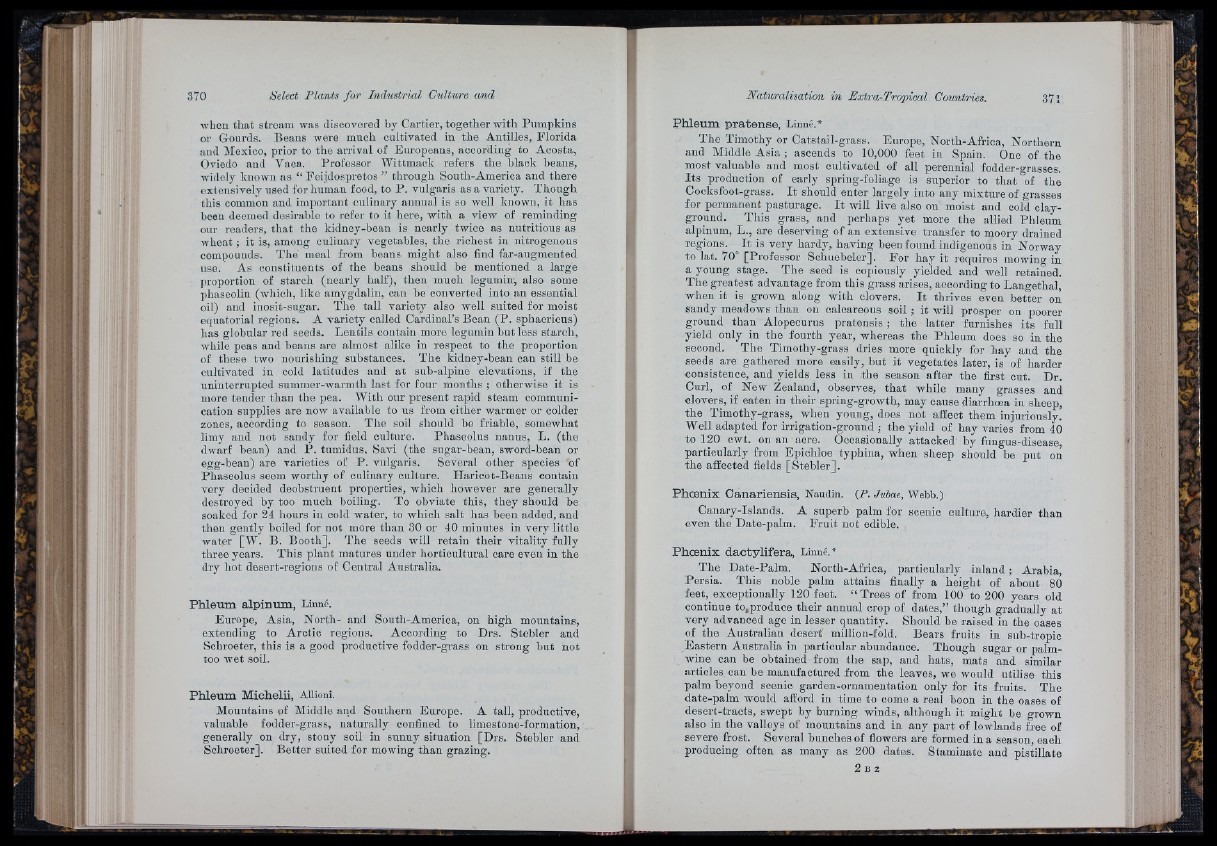
Select Plants fo r In d u stria l Culture and
when that stream was discovered l)y Cartier, together with Pnmpkins
or Gourds. Beans were much cultivated in the Antilles, Florida
and Mexico, prior to the arrival of Europeans, according to Acosta,
Oviedo and Vaoa. Professor Wittmack refers the black beans,
widely known as “ Feijdospretos ” tlirough South-America and there
extensively used for human food, to P. vulgaris as a variety. Though
this common and important culinary annual is so well known, it has
been deemed desirable to refer to it here, with a view of reminding
oiir readers, th a t the kidney-bean is nearly twice as nutritious as
w h e a t; it is, among culinary vegetables, the richest in nitrogenous
compounds. The meal from beans might also find far-augmented
use. As constituents of the beans should be mentioned a large
proportion of starcli (nearly half), then much legumin, also some
phaseolin (whicii, like amygdalin, can be converted into an essential
oil) and inosit-sugar. The tall variety also well suited for moist
equatorial regions. A variety called Cardinal’s Bean (P. sphaericus)
has globular red seeds. Lentils contain more legumin but less starch,
wliile peas and beans are almost alike in respect to the proportion
of these two nourishing substances. The kidney-bean can still he
cultivated in cold latitudes and a t sub-alpine elevations, if the
uninterrnpted summer-warmth last for four montlis ; otherwise it is
more tender than the pea. With our present rapid steam communication
supplies are now available to us from either warmer or colder
zones, according to season. The soil should be friable, somewhat
limy and not sandy for field culture. Phaseolus nanus, L. (the
dwarf bean) and P . tumidus, Savi (the sngar-bean, sword-bean or
egg-bean) are varieties of P . vulgaris. Several other species of
Phaseolus seem worthy of culinary culture. Harioot-Beans contain
very decided deobstruent properties, which however are generally
destroyed by too much boiling. To obviate this, they should he
soaked for 24 hours in cold water, to which salt has been added, and
then gently boiled for not more than 30 or 40 minutes in very little
water [W. B. Booth], The seeds will retain their vitality fully
tliree years. This plant matures under horticultural care even in the
dry hot desert-regions of Central Australia.
P h l e u m a lp in u m , Liimf.
Europe, Asia, North- and South-America, on high mountains,
extending to Arctic regions. According to Drs. Stebler and
Schroeter, this is a good productive fodder-grass on strong but not
too wet soil.
P h l e u m M ic h e lii, Allioni.
Mountains of Middle and Southern Europe. A tall, productive,
valuable fodder-grass, naturally confined to limestone-formation,
generally on dry, stony soil in sunny situation [Drs. Stebler and
Schroeter]. Better suited for mowing than grazing.
P h l e u m p r a te n s e , Linno.*
The Timothy or Catstail-grass. Europe, North-Africa, Northern
and Middle Asia ; ascends to 10,000 feet in Spain. One of the
most valuable and most cultivated of all perennial fodder-grasses.
Its production of early spring-foliage is superior to tliat of the
Cocksfoot-grass. I t should enter largely into any mixture of grasses
for permanent pasturage. I t will live also on moist and cold clay-
ground. This grass, and perhaps yet more the allied Phleum
alpinum, L., are deserving of an extensive transfer to moory drained
regions. I t is very hardy, having been found indigenous in Norway
to lat. 70° [Professor Schuebeler]. For hay it requires mowing in
a young stage. The seed is copiously yielded and well retained.
The greatest advantage from this grass arises, according to Langethal,
when it is grown along with clovers. I t thrives even better on
sandy meadows than on calcareous soil ; it will prosper on poorer
ground than Alopecurus pratensis ; the latter furnishes its full
yield only in the fourth year, whereas the Phleum does so in the
second. The Timothy-grass dries more quickly for hay and the
seeds are gathered more easily, but it vegetates later, is of harder
consistence, and yields less in the season after the first cut. Dr.
Curl, of New Zealand, observes, that while many grasses and
clovers, if eaten in their spring-growth, may cause diarrhoea in sheep,
the Timothy-grass, when young, does not affect them injuriously.
Well adapted for irrigation-ground ; the yield of hay varies from 40
to 120 cwt. on an acre. Occasionally attacked by fungus-disease,
particularly from Epiohloe typhina, when sheep should be put on
the affected fields [Stebler].
P h oe n ix C a n a r ie n s is , Naudin. (P. Jubae, Webb.)
Canary-Islands. A superb palm for scenic culture, hardier than
even the Date-palm. Fruit not edible.
P h oe n ix d a o ty lif e r a , Linné.»
The Date-Palm. North-Afriea, particularly inland ; Arabia,
Persia. This noble palm attains finally a height of about 80
feet, exceptionally 120 feet. “ Trees of from 100 to 200 years old
continue to^produce their annual crop of dates,” though gradually at
very advanced age in lesser quantity. Should be raised in the oases
of the Australian desert million-fold. Bears fruits in sub-tropic
Eastern Australia in particular abundance. Though sugar or palm-
wine can be obtained from the sap, and hats, mats and similar
articles can be manufactured from the leaves, we would utilise this
palm beyond scenic garden-ornamentation only for its fruits. The
date-palm would afford in time to come a real boon in the oases of
desert-tracts, swept by burning winds, although it might be grown
also iu the valleys of mountains and in any part of lowlands free of
severe frost. Several bunches of flowers are formed in a season, each
producing often as many as 200 dates. Staminate and pistillate